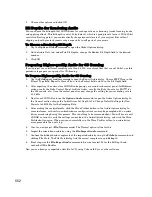
537
Engl
ish
MIDI Machine Control (MMC)
MIDI Machine Control (MMC) is a protocol that controls an MMC-equipped remote device via MIDI.
SONAR lets you use MMC to start and stop playback and recording on remote MIDI devices such as
tape decks, video recorders, and even other software packages. If you have several MMC-controllable
devices in your studio, assign each a unique Unit ID so that MMC commands can be addressed to a
particular device.
MMC is very powerful when used with MIDI Time Code sync. For example, suppose you have an MMC-
equipped digital tape deck that generates time code and want to use the tape deck as the timing master
for a project. You can set up your equipment and software so that the transport controls in SONAR send
MMC messages to the tape deck, which in turn starts and stops playback in SONAR via SMPTE/MTC
Sync. In this configuration, SONAR’s transport buttons (Play, Record, and Stop) are simply remote
control substitutes for the buttons on your tape deck. In this type of configuration, you must choose one
MMC-controllable device as the time code master.
When MMC is enabled, press Play to start playback on all connected MMC devices, and press Stop to
stop all connected devices. If you press Record while playback is underway, all connected MMC devices
(e.g., tape decks) begin recording on any armed tracks. If you stop recording (without stopping
playback), SONAR instruct the tape decks to punch out. You must arm and disarm tracks on the tape
deck; you cannot do this from SONAR.
If you have established punch-in/out points using the
Transport-Record Options
command, SONAR
will attempt to preprogram the punch-in and punch-out times. However, your equipment must
recognize the MMC event command for this feature to work. (Consult the owner’s manual or contact the
equipment manufacturer for more information.) If your equipment behaves erratically with automated
punch-in, don’t attempt to use it when those pieces of equipment are connected.
SONAR instructs MMC devices to locate the current project position only when playback or recording is
started. This prevents excessive wear on the motors and tape heads of the devices.
The frame rate is set incorrectly
The frame rate on the stripe must match the frame
rate you set in SONAR.
The offset is set incorrectly
The offset you enter in SONAR must match the
start time of recorded material on the tape.
SONAR is not configured correctly
Verify and/or repeat the steps in “To Configure
SONAR to Sync to SMPTE/MTC” on page 534.
Audio playback drifts out of sync with the
tape
Enable the Full Chase Lock option, which keeps
audio from freewheeling.
SONAR continues playing for up to one full
second after the time code stops
Some time code readers tolerate dropouts of up to
one second, without affecting playback. When you
stop the tape deck, it takes a full second for the
reader to realize that this isn’t merely a dropout
and to signal the end of the time code to SONAR.
This does not indicate any problem with time code
sync.
Summary of Contents for Cakewalk SONAR
Page 1: ...Cakewalk SONAR User s Guide ...
Page 2: ......
Page 4: ......
Page 22: ...xxii ...
Page 50: ...50 ...
Page 102: ...102 ...
Page 182: ...182 ...
Page 302: ...302 ...
Page 420: ...420 English ...
Page 466: ...466 ...
Page 502: ...502 ...
Page 574: ...574 ...
Page 580: ...580 ...
Page 608: ...608 ...






























